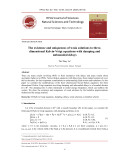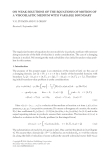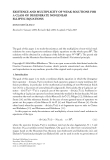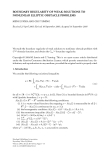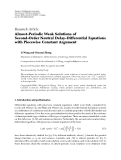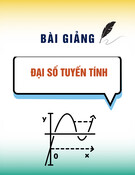
HPU2. Nat. Sci. Tech. Vol 04, issue 01 (2025), 95-102.
HPU2 Journal of Sciences:
Natural Sciences and Technology
Journal homepage: https://sj.hpu2.edu.vn
Article type: Research article
Received date: 20-02-2025; Revised date: 19-3-2025; Accepted date: 31-3-2025
This is licensed under the CC BY-NC 4.0
95
The existence and uniqueness of weak solutions to three-
dimensional Kelvin-Voigt equations with damping and
unbounded delays
Thi-Thuy Le
*
Electric Power University, Hanoi, Vietnam
Abstract
There are many results involving PDEs in fluid mechanics with delays and many results about
asymptotic behavior to PDEs. Navier-Stokes equations with delays have been studied extensively over
the last decades, for their important contributions to understanding fluid motion and turbulence. In this
paper we consider the modifications of the three dimensional Navier-Stokes equations: the three
dimensional Kelvin-Voigt equations involving damping and unbounded delays in a bounded domain
Ω⊂ℝ
. The damping term is often introduced to model energy dissipation, which can stabilize the
system. We show the existence and uniqueness of weak solutions by the Galerkin approximations
method and the energy method.
Keywords: 3D Kelvin-Voigt equations, damping, delays, weak solutions, a Galerkin scheme
1. Introduction
Let Ω be a bounded domain in ℝ
with a smooth boundary 𝜕Ω. In this paper, we consider the
following 3D Kelvin-Voigt equations with damping and delays in Ω,
⎩
⎨
⎧
𝜕
(𝑢−𝛼
Δ𝑢)−𝜈Δ𝑢+∇𝑝+𝜅|𝑢|
𝑢=𝑔(𝑡,𝑢
) + ℎ(𝑡) in (0,𝑇) × Ω,
div𝑢=0 in (0,𝑇) × Ω,
𝑢(𝑥,𝑡)=0 in (0,𝑇) × 𝜕Ω,
𝑢(𝜃,𝑥)=𝜙(𝜃,𝑥), 𝜃∈(−∞,0],𝑥∈Ω, (1)
where 𝜈>0 is the kinematic viscosity, 𝛼>0,𝜅>0,𝛽≥1 are three constants, 𝑢=𝑢(𝑥,𝑡)=
(𝑢
,𝑢
,𝑢
) is the velocity field of the fluid, 𝑝 is the pressure, ℎ is a nondelayed external force field, 𝑔
*
Corresponding author, E-mail: thuylt@epu.edu.vn
https://doi.org/10.56764/hpu2.jos.2024.4.1.95-102





